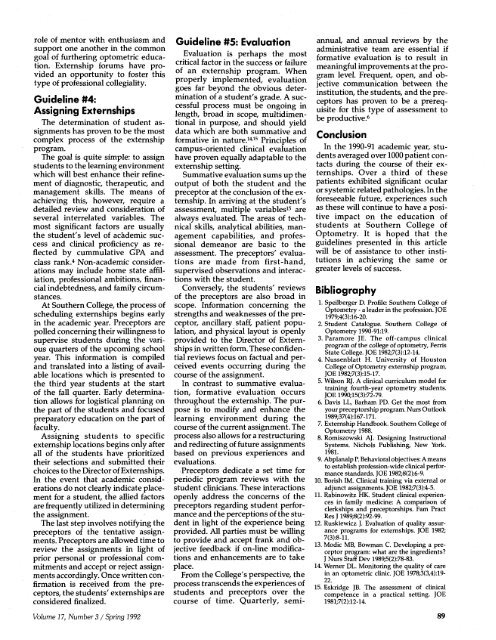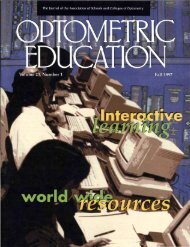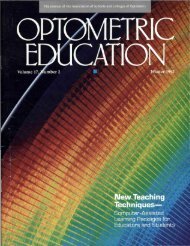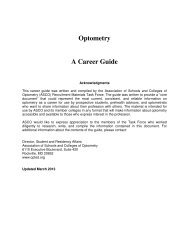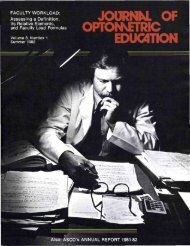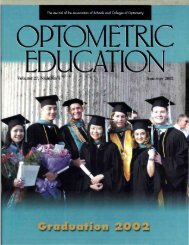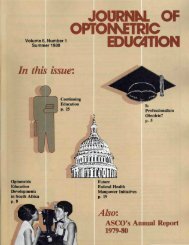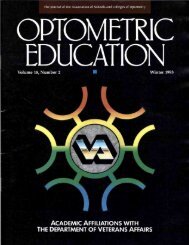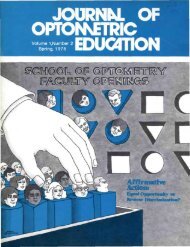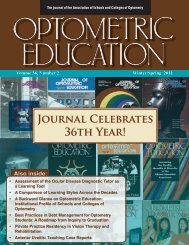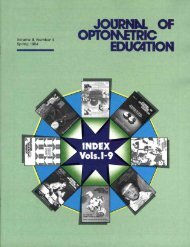Spring 1992, Volume 17, Number 3 - Association of Schools and ...
Spring 1992, Volume 17, Number 3 - Association of Schools and ...
Spring 1992, Volume 17, Number 3 - Association of Schools and ...
You also want an ePaper? Increase the reach of your titles
YUMPU automatically turns print PDFs into web optimized ePapers that Google loves.
ole <strong>of</strong> mentor with enthusiasm <strong>and</strong><br />
support one another in the common<br />
goal <strong>of</strong> furthering optometric education.<br />
Externship forums have provided<br />
an opportunity to foster this<br />
type <strong>of</strong> pr<strong>of</strong>essional collegiality.<br />
Guideline #4:<br />
Assigning Externships<br />
The determination <strong>of</strong> student assignments<br />
has proven to be the most<br />
complex process <strong>of</strong> the externship<br />
program.<br />
The goal is quite simple: to assign<br />
students to the learning environment<br />
which will best enhance their refinement<br />
<strong>of</strong> diagnostic, therapeutic, <strong>and</strong><br />
management skills. The means <strong>of</strong><br />
achieving this, however, require a<br />
detailed review <strong>and</strong> consideration <strong>of</strong><br />
several interrelated variables. The<br />
most significant factors are usually<br />
the student's level <strong>of</strong> academic success<br />
<strong>and</strong> clinical pr<strong>of</strong>iciency as reflected<br />
by cummulative GPA <strong>and</strong><br />
class rank. 4 Non-academic considerations<br />
may include home state affiliation,<br />
pr<strong>of</strong>essional ambitions, financial<br />
indebtedness, <strong>and</strong> family circumstances.<br />
At Southern College, the process <strong>of</strong><br />
scheduling externships begins early<br />
in the academic year. Preceptors are<br />
polled concerning their willingness to<br />
supervise students during the various<br />
quarters <strong>of</strong> the upcoming school<br />
year. This information is compiled<br />
<strong>and</strong> translated into a listing <strong>of</strong> available<br />
locations which is presented to<br />
the third year students at the start<br />
<strong>of</strong> the fall quarter. Early determination<br />
allows for logistical planning on<br />
the part <strong>of</strong> the students <strong>and</strong> focused<br />
preparatory education on the part <strong>of</strong><br />
faculty.<br />
Assigning students to specific<br />
externship locations begins only after<br />
all <strong>of</strong> the students have prioritized<br />
their selections <strong>and</strong> submitted their<br />
choices to the Director <strong>of</strong> Externships.<br />
In the event that academic considerations<br />
do not clearly indicate placement<br />
for a student, the allied factors<br />
are frequently utilized in determining<br />
the assignment.<br />
The last step involves notifying the<br />
preceptors <strong>of</strong> the tentative assignments.<br />
Preceptors are allowed time to<br />
review the assignments in light <strong>of</strong><br />
prior personal or pr<strong>of</strong>essional commitments<br />
<strong>and</strong> accept or reject assignments<br />
accordingly. Once written confirmation<br />
is received from the preceptors,<br />
the students' externships are<br />
considered finalized.<br />
Guideline #5: Evaluation<br />
Evaluation is perhaps the most<br />
critical factor in the success or failure<br />
<strong>of</strong> an externship program. When<br />
properly implemented, evaluation<br />
goes far beyond the obvious determination<br />
<strong>of</strong> a student's grade. A successful<br />
process must be ongoing in<br />
length, broad in scope, multidimentional<br />
in purpose, <strong>and</strong> should yield<br />
data which are both summative <strong>and</strong><br />
formative in nature. 1415 Principles <strong>of</strong><br />
campus-oriented clinical evaluation<br />
have proven equally adaptable to the<br />
externship setting.<br />
Summative evaluation sums up the<br />
output <strong>of</strong> both the student <strong>and</strong> the<br />
preceptor at the conclusion <strong>of</strong> the externship.<br />
In arriving at the student's<br />
assessment, multiple variables 15 are<br />
always evaluated. The areas <strong>of</strong> technical<br />
skills, analytical abilities, management<br />
capabilities, <strong>and</strong> pr<strong>of</strong>essional<br />
demeanor are basic to the<br />
assessment. The preceptors' evaluations<br />
are made from first-h<strong>and</strong>,<br />
supervised observations <strong>and</strong> interactions<br />
with the student.<br />
Conversely, the students' reviews<br />
<strong>of</strong> the preceptors are also broad in<br />
scope. Information concerning the<br />
strengths <strong>and</strong> weaknesses <strong>of</strong> the preceptor,<br />
ancillary staff, patient population,<br />
<strong>and</strong> physical layout is openly<br />
provided to the Director <strong>of</strong> Externships<br />
in written form. These confidential<br />
reviews focus on factual <strong>and</strong> perceived<br />
events occurring during the<br />
course <strong>of</strong> the assignment.<br />
In contrast to summative evaluation,<br />
formative evaluation occurs<br />
throughout the externship. The purpose<br />
is to modify <strong>and</strong> enhance the<br />
learning environment during the<br />
course <strong>of</strong> the current assignment. The<br />
process also allows for a restructuring<br />
<strong>and</strong> redirecting <strong>of</strong> future assignments<br />
based on previous experiences <strong>and</strong><br />
evaluations.<br />
Preceptors dedicate a set time for<br />
periodic program reviews with the<br />
student clinicians. These interactions<br />
openly address the concerns <strong>of</strong> the<br />
preceptors regarding student performance<br />
<strong>and</strong> the perceptions <strong>of</strong> the student<br />
in light <strong>of</strong> the experience being<br />
provided. All parties must be willing<br />
to provide <strong>and</strong> accept frank <strong>and</strong> objective<br />
feedback if on-line modifications<br />
<strong>and</strong> enhancements are to take<br />
place.<br />
From the College's perspective, the<br />
process transcends the experiences <strong>of</strong><br />
students <strong>and</strong> preceptors over the<br />
course <strong>of</strong> time. Quarterly, semiannual,<br />
<strong>and</strong> annual reviews by the<br />
administrative team are essential if<br />
formative evaluation is to result in<br />
meaningful improvements at the program<br />
level. Frequent, open, <strong>and</strong> objective<br />
communication between the<br />
institution, the students, <strong>and</strong> the preceptors<br />
has proven to be a prerequisite<br />
for this type <strong>of</strong> assessment to<br />
be productive. 6<br />
Conclusion<br />
In the 1990-91 academic year, students<br />
averaged over 1000 patient contacts<br />
during the course <strong>of</strong> their externships.<br />
Over a third <strong>of</strong> these<br />
patients exhibited significant ocular<br />
or systemic related pathologies. In the<br />
foreseeable future, experiences such<br />
as these will continue to have a positive<br />
impact on the education <strong>of</strong><br />
students at Southern College <strong>of</strong><br />
Optometry. It is hoped that the<br />
guidelines presented in this article<br />
will be <strong>of</strong> assistance to other institutions<br />
in achieving the same or<br />
greater levels <strong>of</strong> success.<br />
Bibliography<br />
1. Speilberger D. Pr<strong>of</strong>ile: Southern College <strong>of</strong><br />
Optometry - a leader in the pr<strong>of</strong>ession. JOE<br />
1979;4(3):16-20.<br />
2. Student Catalogue. Southern College <strong>of</strong><br />
Optometry 1990-91:19.<br />
3. Paramore JE. The <strong>of</strong>f-campus clinical<br />
program <strong>of</strong> the college <strong>of</strong> optometry, Ferris<br />
State College. JOE 1982;7(3):12-14.<br />
4. Nussenblatt H. University <strong>of</strong> Houston<br />
College <strong>of</strong> Optometry externship program.<br />
JOE 1982;7(3):15-<strong>17</strong>.<br />
5. Wilson RJ. A clinical curriculum model for<br />
training fourth-year optometry students.<br />
JOE 1990;15(3):72-79.<br />
6. Davis LL, Barham PD. Get the most from<br />
your preceptorship program. Nurs Outlook<br />
1989;37(4):167-<strong>17</strong>1.<br />
7. Externship H<strong>and</strong>book. Southern College <strong>of</strong><br />
Optometry 1988.<br />
8. Romiszowski AJ. Designing Instructional<br />
Systems. Nichols Publishing, New York.<br />
1981.<br />
9. Abplanalp P. Behavioral objectives: A means<br />
to establish pr<strong>of</strong>ession-wide clinical performance<br />
st<strong>and</strong>ards. JOE 1982;8(2):6-9.<br />
10. Borish IM. Clinical training via external or<br />
adjunct assignments. JOE 1982;7(3):4-5.<br />
11. Rabinowitz HK. Student clinical experiences<br />
in family medicine: A comparison <strong>of</strong><br />
clerkships <strong>and</strong> preceptorships. Fam Pract<br />
Res J 1989;8(2):92-99.<br />
12. Ruskiewicz J. Evaluation <strong>of</strong> quality assurance<br />
programs for externships. JOE 1982;<br />
7(3):8-ll.<br />
13. Modic MB, Bowman C. Developing a preceptor<br />
program: what are the ingredients?<br />
J Nurs Staff Dev 1989;5(2):78-83.<br />
14. Werner DL. Monitoring the quality <strong>of</strong> care<br />
in an optometric clinic. JOE 1978;3(3,4):19-<br />
22.<br />
15. Eskridge JB. The assessment <strong>of</strong> clinical<br />
competence in a practical setting. JOE<br />
1981;7(2):12-14.<br />
<strong>Volume</strong> <strong>17</strong>, <strong>Number</strong> 3 / <strong>Spring</strong> <strong>1992</strong> 89


